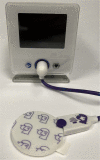Non-invasive Brain Temperature Measurement in Acute Ischemic Stroke
- PMID: 35989905
- PMCID: PMC9388770
- DOI: 10.3389/fneur.2022.889214
Non-invasive Brain Temperature Measurement in Acute Ischemic Stroke
Abstract
Selective therapeutic hypothermia in the setting of mechanical thrombectomy (MT) is promising to further improve the outcomes of large vessel occlusion stroke. A significant limitation in applying hypothermia in this setting is the lack of real-time non-invasive brain temperature monitoring mechanism. Non-invasive brain temperature monitoring would provide important information regarding the brain temperature changes during cooling, and the factors that might influence any fluctuations. This review aims to provide appraisal of brain temperature changes during stroke, and the currently available non-invasive modalities of brain temperature measurement that have been developed and tested over the past 20 years. We cover modalities including magnetic resonance spectroscopy imaging (MRSI), radiometric thermometry, and microwave radiometry, and the evidence for their accuracy from human and animal studies. We also evaluate the feasibility of using these modalities in the acute stroke setting and potential ways for incorporating brain temperature monitoring in the stroke workflow.
Keywords: acute stroke; hypothermia; magnetic resonance spectroscopy or MRS; non-invasive temperature measurement; non-invasive temperature monitoring.
Copyright © 2022 Horn, Diprose, Pichardo, Demchuk and Almekhlafi.
Conflict of interest statement
MA received Bair Hugger™ sensors from 3M™ as an educational grant for conduct of a clinical study. He also serves on the scientific advisory board of Palmera Medical, Inc. AD is a consultant for Medtronic, Circle NVI, and NovaSignal. The remaining authors declare that the research was conducted in the absence of any commercial or financial relationships that would be constructed as a potential conflict of interest.
Figures


Similar articles
-
Modeling selective therapeutic hypothermia in case of acute ischemic stroke using a 1D hemodynamics model and a simplified brain geometry.Math Biosci Eng. 2019 Nov 15;17(2):1147-1167. doi: 10.3934/mbe.2020060. Math Biosci Eng. 2019. PMID: 32233574
-
Selective Brain Hypothermia for Ischemic MCA-M1 Stroke: Influence of Cerebral Arterial Circulation in a 3D Brain Temperature Model.IEEE Trans Biomed Eng. 2021 Feb;68(2):404-415. doi: 10.1109/TBME.2020.3000521. Epub 2021 Jan 20. IEEE Trans Biomed Eng. 2021. PMID: 32746020
-
Non-invasive measurement of brain temperature using radiometric thermometry: experimental validation and clinical observations in asphyxiated newborns.J Neonatal Perinatal Med. 2014;7(4):279-86. doi: 10.3233/NPM-14814041. J Neonatal Perinatal Med. 2014. PMID: 25468621
-
Review of selective brain hypothermia in acute ischemic stroke therapy using an intracarotid, closed-loop cooling catheter.Brain Circ. 2019 Dec 27;5(4):211-217. doi: 10.4103/bc.bc_54_19. eCollection 2019 Oct-Dec. Brain Circ. 2019. PMID: 31950097 Free PMC article. Review.
-
Selection of preclinical models to evaluate intranasal brain cooling for acute ischemic stroke.Brain Circ. 2019 Dec 27;5(4):160-168. doi: 10.4103/bc.bc_20_19. eCollection 2019 Oct-Dec. Brain Circ. 2019. PMID: 31950091 Free PMC article. Review.
Cited by
-
Model-predicted brain temperature computational imaging by multimodal noninvasive functional neuromonitoring of cerebral oxygen metabolism and hemodynamics: MRI-derived and clinical validation.J Cereb Blood Flow Metab. 2025 Feb;45(2):275-291. doi: 10.1177/0271678X241270485. Epub 2024 Aug 11. J Cereb Blood Flow Metab. 2025. PMID: 39129194 Free PMC article.
-
Penumbral cooling in ischemic stroke with intraarterial, intravenous or active conductive head cooling: A thermal modeling study.J Cereb Blood Flow Metab. 2024 Jan;44(1):66-76. doi: 10.1177/0271678X231203025. Epub 2023 Sep 21. J Cereb Blood Flow Metab. 2024. PMID: 37734834 Free PMC article.
References
Publication types
LinkOut - more resources
Full Text Sources
Miscellaneous

